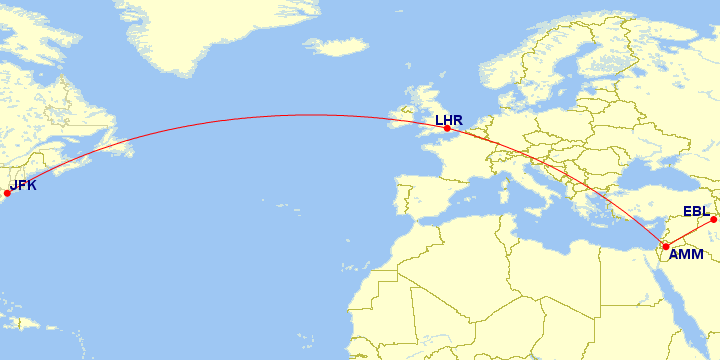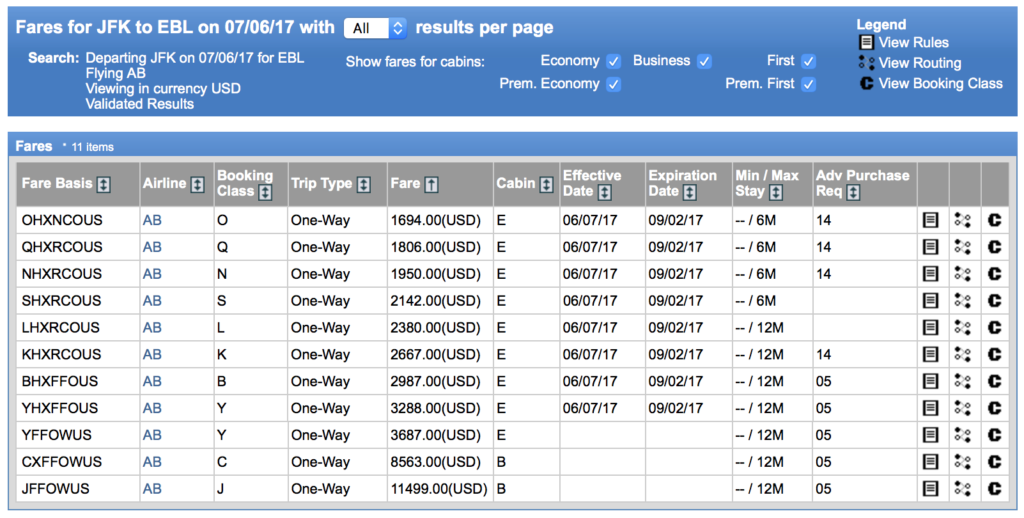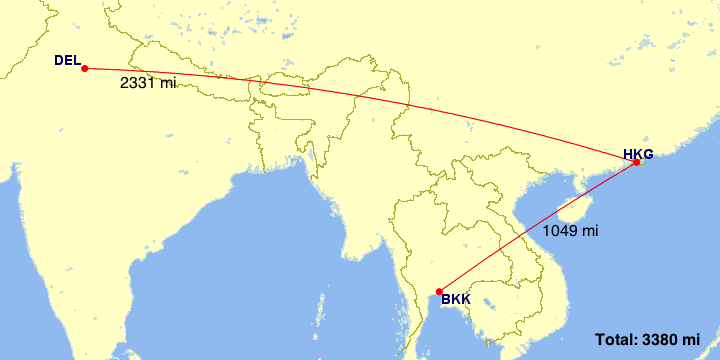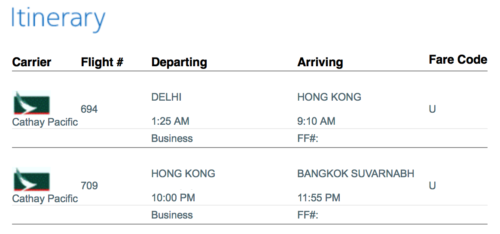If you read the guides to booking tickets using American Airlines AAdvantage miles out there, there are two main “rules” that get repeated over and over.
- The over-water carrier must publish a fare between your origin and destination.
- The total distance flown in your itinerary must not be more than 25% over the “Maximum Permitted Mileage” (MPM).
If your routing breaks either of this rule, you can still book the ticket. However, you will have to break it up until each individual award satisfies both of these rules. This is usually not worth it, since most likely you will be end up paying a high price for a intra-region ticket this way, on top of a long-haul ticket.
American doesn’t make these two rules very transparent and official, so I was determined to find out whether they are still enforced.
Overwater Carrier Must Publish Fare Between Origin and Destination
The first “rule” means the carrier on your itinerary that flies over water (likely the longest flight) must publish a fare (i.e. sell tickets) between the origin and destination on your itinerary. This rule isn’t all that problematic, because for the most part as long as you are within one connection, there is usually a published fare.
But let’s take a look at an example. Let’s say you want to fly from New York (JFK) to Erbil, Iraqi Kurdistan (EBL). I know. Not the most likely redemption, but I’ve actually booked it before, so work with me here. American Airlines’ routing rules allow you to fly between the US and the Middle East via Europe, so a possible routing might be New York – London – Amman – Erbil.

You might want to route through London and Amman for a flight from New York to Erbil.
In this case, the over-water flight is New York (JFK) to London (LHR). The logical carriers of choice would probably either be American Airlines or British Airways. However, neither of them publishes a fare between New York and Erbil, so you won’t be able to redeem a ticket that routes like above.

Neither American Airlines or British Airways—the over-water carrier—publishes a fare between New York and Erbil.
However, Air Berlin does publish a fare between New York and Erbil.

Air Berlin publishes a fare between New York (JFK) and Erbil (EBL).
As a result, you can use Air Berlin as the over-water carrier in your itinerary, and theoretically book a routing like New York – Berlin – Amman – Erbil (see more below).
I have been told by an agent about this rule, and of all the routes I’ve booked with American, I have no evidence to say that this rule isn’t enforced. Itineraries don’t often run into problems that involve this rule anyway, so I have no reason to believe that it’s a “made up” rule.
Itinerary Must Not Exceed 125% of Maximum Permitted Mileage (MPM)…
The second “rule” is likely in place to prevent back-tracking and unnecessary segments.
It’s worth noting that American has recently imposed a new restriction on the number of segments you are allowed to include on an award ticket itinerary.
For each one-way award redeemed for travel within the United States and Canada, a maximum of three segments are permitted. For all other destinations (including Puerto Rico and U.S. Virgin Islands), a maximum of four segments are permitted.
However, American Airlines has a zone-based award chart, and they also have very strict routing rules about which zone you can fly through on a given ticket. These zone-based rules have been so restrictive that the MPM “rule” is almost unnecessary…most of the time.
Imagine there wasn’t a rule about how far you can fly between points A and B, as long as you are not going into other regions. Let’s say you want to go from Osaka (KIX, Asia 1) to Taipei (TPE, Asia 2). Instead of taking a direct flight on Cathay Pacific, you love planes so much that you decided that this routing might be more fun. Osaka (KIX) – Sapporo (CTS) – Tokyo (NRT) – Seoul (ICN) – Hong Kong (HKG) – Taipei (TPE).

Doesn’t this look like a fun routing?
Instead of taking the 1,058-mile direct flight between Osaka (KIX) and Taipei (TPE) that both Cathay Pacific and Japan Airlines offer, you hop around “Asia 1” and “Asia 2” in the most circuitous route possible. American probably doesn’t want to pay for all those “extra” flights, so they have another “rule” in place. The total distance flown cannot be more than 125% of the maximum permitted mileage (MPM).
You can look up MPM on sites like ExpertFlyer, and they will even show you what 25% over the MPM (the purported limit American imposes) is.

125% of the maximum permitted mileage (MPM) between Osaka (KIX) and Taipei (TPE) is 1,591 miles.
The “25M” shows you what 25% over the MPM is. So in this case, American seems to be saying you can route to your heart’s content, as long as (1) you don’t transit through a third region, (2) the total distance travelled is under 1,591 miles, and (3) you don’t violate the segment limit.
For the most part, this is actually pretty generous. If you’re taking a long-haul flight, you usually have quite a bit of leeway when it comes to routing. However, on shorter flights that might have limited routing options, it can become a bit of a pain.
But is this such a hard and fast rule?
…Except When It Can
Let’s take a look at two itineraries tickets I recently booked with AAdvantage miles succesfully. In either case, the total distance flown in the itineraries exceeded 25% of the MPM.
First up, Delhi to Bangkok via Hong Kong on Cathay Pacific.

This itinery routes from New Delhi to Bangkok via Hong Kong.
A route like this brings the total distance flown to 3,380 miles. For reference, flying direct between Delhi (DEL) and Bangkok (BKK) is 1,831 miles.
If you look on ExpertFlyer, you will see that the maximum permitted mileage between Delhi (DEL) and Bangkok (BKK) is 2,188 miles. 25% over that would be 2,735 miles. According to the “rule,” American Airlines would not allow a routing like this.

125% of the maximum permitted mileage (MPM) between Delhi (DEL) and Bangkok (BKK) is 2735 miles.
But guess what? I called up American and booked the ticket without a hitch. I was correctly charged 40,000 miles for the ticket, and I actually flew on this route, so it’s more than just an exercise.


American Airlines charged me 40,000 miles for the ticket between Delhi and Bangkok, despite the fact that it exceeded the purpoted “rule” about MPM.
Maybe I got lucky. Maybe this was an exception.
But let’s look at another route, which was also both successfully booked and flown. In this instance, I was booking a ticket from Male, Maldives (MLE) to Melbourne (MEL). American Airlines calls Maldives part of the Middle East (unlike Alaska, which groups Maldives under Asia), so I wanted to fly Etihad’s First Class Apartment on the A380 to Melbourne.
But flying through Abu Dhabi is back-tracking, and actually quite a bit of it. The total flying distance in an itinerary like that would come to 9,111 miles.

Flying from Male (MLE) to Melbourne (MLE) via Abu Dhabi involves some back-tracking.
9,111 miles, of course, is well over 125% of the MPM, which is 8,793 miles for this particular route.

125% of the maximum permitted mileage (MPM) between Male and Melbounre is 8,793 miles.
So according to this “125% MPM” rule, American Airlines wouldn’t allow a ticket like that, right?
And…booked. American Airlines charged me 100,000 AAdvantage miles + taxes for this ticket, which is what a First Class award between the Middle East and South Pacific would cost.
What’s Happening Here?
I suspect the “real” routing rule is really dependent on the published fare by the over-water carrier. It seems to me that you can exceed the MPM by more than 25%, if it’s a routing that is specifically allowed in the routing rule by the over-water (or “governing”) carrier.
For example, Cathay Pacific’s published fare rule allows transit in Hong Kong, so I was able to book Delhi – Bangkok via Hong Kong, even though it exceeds the MPM by more than 25%. Similarly, Etihad is the governing carrier on my Male to Melbourne itinerary, and their fare rule allows routing through Abu Dhabi, which makes sense because it’s their hub.
Takeaway
If my suspicion is true, this is good news for those booking award tickets involving destination pairs that only have a handful of available routes. I don’t think American has done away with the “125% of MPM” rule, but it’s not a hard and fast rule that’s always enforced. If the fare rule by the overwater carrier allows a certain route, changes are it’s a permitted option.
Sometimes us really savvy points and miles enthusiasts do so much research before calling in to book a ticket, that we may have actually restricted ourselves with “rules” that can be broken. When in doubt, call in and ask. The worst thing that can happen is multiple HUCAs and a “no” at the end of the day.
If you need help on booking award travels, you can always check out Juicy Miles, our award booking service!
The responses below are not provided or commissioned by the bank advertiser. Responses have not been reviewed, approved or otherwise endorsed by the bank advertiser. It is not the bank advertiser's responsibility to ensure all posts and/or questions are answered.
3 comments
I see the MPM+25 rule as just a deterrent against obvious cases of routing abuse. The published fare criteria, on the other hand, is totally ridiculous. The whole notion of airline partnerships is that it allows flyers to explore somewhere completely out of their comfort zone.
But I guess that mentality also fits well with AA’s underlying philosophy that only “domestic cornerstones” and “global cornerstones” matter.
I’m trying to determine whether the following would meet all AA’s routing rules:
PPT-AKL-HKG-NRT in business, with the first leg on ATN, second on CX and third on CX.
Allowed South pacific to Asia 1 through Asia 2, and Cathay publishes a fare. It’s slightly over the MPM though. I believe this should price at 40k miles each one way in business?
[…] travel from the Americas to or from Asia, Africa, or the South Pacific you’ll be in violation of American’s rules prohibiting transit through a third region. The only way to book a prohibited routing is to book two separate awards tickets – which […]